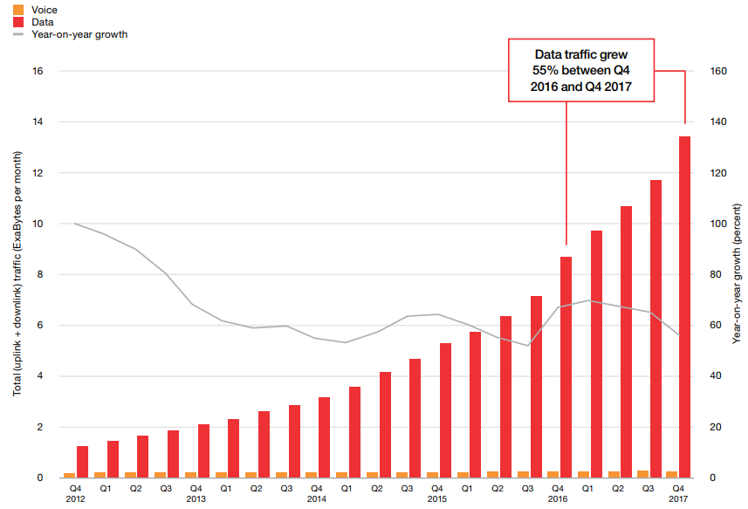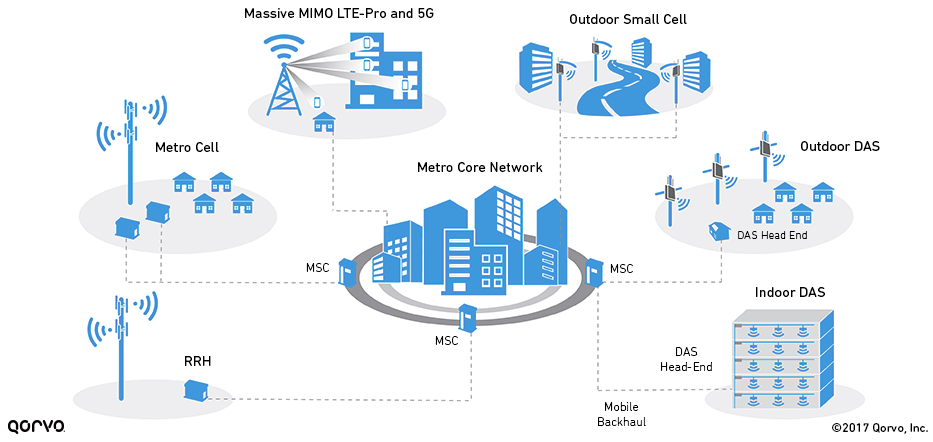
In 2017, the global population was 7.56 billion. However, according to the latest Ericsson Mobility Report, there were around 7.8 billion mobile subscriptions at the end of 2017, for a penetration rate of 103 percent. Of those, 5.2 billion are broadband subscriptions. Unsurprisingly, mobile data traffic dwarfs voice traffic, driven primarily by more video content viewed at higher resolutions—by 2021, video is forecast to constitute 75 percent of data usage. As shown by the chart, data traffic is on a tear: in fact, the 55 percent year-on-year growth represents a slight slowdown from the previous four quarters, which notched year-on-year figures of 65 to 70 percent. It looks like 5G, the fifth generation of wireless standards, will arrive in the nick of time.
The new standard certainly sets ambitious goals. Compared to 4G, 5G aims for a 10X decrease in end-to-end latency, 100X traffic capacity and network efficiency, three times the spectrum efficiency, and 10 times the connection density. 5G will include both mobile and fixed-base wireless applications; for example, a 5G modem can replace fiber-to-the-home (FTTH) installations with wireless connections.
Aside from making life easier for online gamers and movie buffs, 5G’s increased performance will spawn a slew of new services over the next few years. Video streaming, for example, will add ultra-high-definition (4K, 8K) and 3D video, along with virtual reality. Ultra-high-fidelity virtual reality can consume 50 times the bandwidth of an HD video stream. The Internet of Things (IoT) will be able to add real-time interactivity to applications ranging from remote inspection and maintenance, to robotic surgery. Of course, let’s not forget the coming automotive “Brave New World” of autonomous vehicles, advanced driver-assistance systems (ADAS), vehicle-to-vehicle (V2V) communications, and more.
5G NR: The First Wave
The first 5G installations are on the horizon. 3GPP, the organization that set standards for earlier wireless network technologies, approved Release 15 in late-2017: this standard will pave the way for transitions from 4G LTE to 5G New Radio (NR)—the first global standard for fifth-generation networks. The standard defines waveforms, channel coding and modulation schemes, plus advanced antenna techniques that open up new frequency bands previously unusable by mobile networks.
The 5G NR specification covers three frequency ranges: low-band (below 1 GHz); mid-band (1 GHz to 6 GHz); and high-band (above 24 GHz), known as mmWave in 5G parlance.
The initial deployments will concentrate on the low and mid bands. The 3GPP standard defines non-standalone (NSA) and standalone (SA) standards: NSA is intended to support connection with older LTE towers, and SA covers newer 5G networks built solely with 5G infrastructure. It’s expected that initially, the new 5G antennas will co-located with existing LTE installations.
Massive MIMO antennas are a key 5G requirement. MIMO stands for multiple-input, multiple-output: a MIMO installation increases the number of antennas on a radio, and can simultaneously accommodate multiple users. For example, a radio using 4T4R MIMO would have four antennas used to both transmit and receive. Compared to single-antenna systems, a MIMO system improves spectral efficiency—the useful information rate that can be transmitted over a given bandwidth in a specific communication system, measured in bits/sec/Hz.
The MIMO concept has been around for a while; WiFi and LTE networks both use MIMO antennas. Most deployments of LTE are either 2T2R or 4T4R, although Sprint has deployed 8T8R MIMO in its 2.5 GHz time-division multiplexed (TDD) band.
“Massive” has no number attached, and merely means “many more than are currently used.” In practice, base stations in 5G may well have arrays of 128 or 256 mini-antennas, and 5G devices (e.g., tablets or smartphones) will have between two and 10 mini-antennas.
In a real-world application, the signal from each transmitting antenna in the MIMO array is reflected off various obstacles before it reaches the receiver. The receiver, therefore, sees a multipath signal with several versions of the transmission, each one with its own delay, attenuation, and direction. Each version can be used to improve quality of the received signal if the system corrects for the spatial environment between each transmitter antenna and the receiver.
This spatial characterization is typically performed by the base station, which analyzes an uplink pilot signal sent from the device; the channel state information (CSI) matrix thus formed is used to “precode” the data before transmission, so that the multipath signal is coherently received at the other end.
The base station performs inverse operations on incoming messages from the device. As the device moves, it must send new pilot signals that allow the base station to recalculate the matrix. This is known as beamforming in the context of a massive MIMO installation, although, it’s different from the technique’s traditional version.
A key technology issue to be solved before 5G SA implementation stems from physics of the high-band frequency spectrum. The mmWave band encompasses the traditional millimeter-wave region, which occupies the frequencies from 30 GHz to 300 GHz (1 mm to 10 mm wavelengths—remember f = c/λ?).
Millimeter waves have long been used for fixed line-of-sight (LOS) satellite and backhaul, but not mobile communications because they’re susceptible to blockage from numerous sources—foliage, rain, stray heads, hands, (and feet). Research shows attenuation of up to 40 dB when signals travel through common materials like brick, walls, doors, and (especially) UV-tinted windows.

This characteristic of mmWave signals, coupled with the massive increase from users and traffic, forces a change in the number and nature of cell sites. The current mobile network relies on a relatively small number of macrocell base stations with a range of twenty miles or more, and antennas mounted high on cellphone towers or rooftops. In areas with very dense phone usage, lower-power microcells add network capacity; picocells and even femtocells serve successively smaller areas.
Given the difficulties of propagating mmWave signals, a 5G implementation is expected to require thousands of very-low-power base stations close together, potentially plus other installations to relay signals to building interiors. Such installations will be ubiquitous—certainly on every street corner and perhaps in many homes.
As shown in Figure 2, the 5G network will be extremely diverse: key elements will include massive MIMO, small and large cells, indoor and outdoor distributed antenna systems (DAS), remote radio heads (RRH), and mobile switching centers (MSC).
5G Products? Coming soon
Broad deployment of 5G networks isn’t expected until 2020, but several of the usual suspects announced 5G chip sets in anticipation of the first 5G-capable consumer products next year.
Qualcomm is perhaps the most advanced: its Snapdragon X50 5G modem platform consists of the X50 5G modem chip plus the SDR051 mmWave transceiver, and will support 28 GHz mmWave operation, together with MIMO and adaptive beamforming. The platform can support non-line-of-sight mmWave use cases, along with multi-mode 4G/5G connectivity.
Intel® XMM™ 8060 is expected to ship in commercial customer devices in mid-2019. The company’s first commercial 5G modem delivers multi-mode support for the full 5G NR NSA and SA implementations, plus legacy modes such as 2G, 3G (including CDMA), and 4G.
Samsung has announced they expect to start using their own Exynos 5G modem in their 2019 phones. The Exynos 5G also supports NSA and SA operation.
What of Apple, you ask? Good question. As of this writing, their 5G strategy isn’t clear. Apple-watchers are divided as to whether the company will go with Qualcomm, Samsung, Intel, someone else, or even wait until they can use their own 5G modem.

